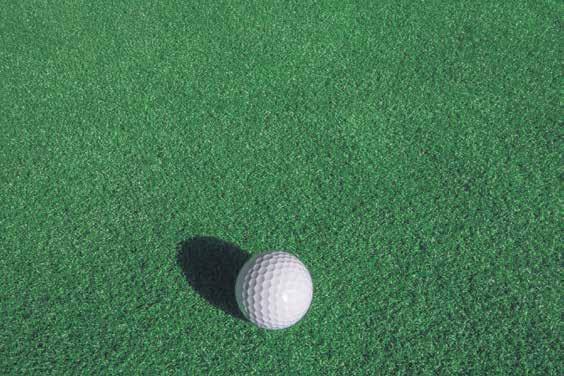
7 minute read
GARDEN WITH
Jill Ross from Mitre 10 Bribie Island. (Meet Jill on the floor at Mitre 10).
Jill is a horticulturist and has an Associate Diploma in Horticulture and has worked in the horticulture industry at various nurseries round the greater Brisbane area for 30 years
Advertisement
Hi Gardeners,
It is the beginning of winter and a feeling of contentment settles into the garden, signalling cold nights. Let’s take a moment to reflect upon the positive side to winter’s ways. These cold mornings have a devastating effect on many garden pests like spider mite and aphids. Although some damage will occur to soft-leaf and fleshystemmed plants, resist the temptation to prune as this will leave the plants even more vulnerable during further cold periods ahead.
GENERAL PLANTING GUIDE
You have just arrived home with your new plants. Water the plants thoroughly each day and place in a semi-shaded position until you are ready to plant out the same day. Do not wave the hose across the foliage and pot but fill the pot with water two or three times, allowing it to soak away in between each water. Remember – plants in pots dry out much quicker than those planted in the ground, so you should plant your trees or shrubs as soon as possible after getting them home.
• Dig the hole twice the size of the plant’s pot size. Dig a square hole not a ‘well’.
• Blend soil from the hole with compost and blood and bone fertiliser.
• Spike the hole with a garden fork to create good drainage. If the hole is not spiked, it may form a ‘well’ when the plant is watered.
• Remove plant from pot and gently tease out any twisted roots from root-ball (with the exception of bougainvillea and native plants). Do not leave to dry out.
• Maintain a strict watering pattern every day for a period of two weeks. After the two-week period, reduce watering until a pattern is found to meet the needs of the plant, soil and weather conditions.
Enjoy your plants!
Gerberas
compost.
Carefully remove the plant from its container and hose away about one half of the potting mix. This allows the roots to extend out into the new soil, letting the plant become established quicker. Plant the crown of the new gerbera at, or slightly above, soil level in the prepared garden bed. A light application of Rose
The first sign of stress is wilting of the tips and/or leaves and a plant still in its pot should be quickly immersed in a bucket of water and left until the bubbles stop. Sometimes, if the plant has been in this stressful state for a period of an hour or more, temporary damage can be done to the plant. However, most plants will respond to a thorough soaking.
Now everyone can be a successful gardener. All you need is common sense and a little guidance. Following are some basic steps which should get your new trees and shrubs growing in no time and make you proud to have produced such results. Remember, plant a tree today for a cool shady tomorrow.

When purchasing plants, take note of their height at maturity, preferred position and any special water requirements and match these carefully to your planting position. Water the plant thoroughly every day from purchasing to planting. Don’t let the pot dry out.
Place a portion of blended soil and compost into the hole, then place the plant in the hole so that the surface of the root-ball and surrounding soil is level. Replace blended soil around
Mound soil around the top of root-ball to create a slight depression to catch
Add recommended rate of slow-release fertiliser e.g. Osmocote around
Cover surface around the plant with mulch (e.g. tea tree, Lucerne, pine bark chip), to help maintain and prevent weeds. DO NOT build mulch up around the trunk of the plant as this
Water the plant thoroughly.
• If required, place a garden stake outside root-ball of plant and push gently into ground. Tie plant to stake in a loose manner to allow plant movement and growth – remove when the plant is strong enough to support itself or it will become weak. Remove the label as it may tighten and cause stunting of growth.
• Buy a photo album to keep your labels as future reference. That way they are not blowing away in the garden.
These have been one of the most popular plants grown in gardens for decades. Bearing single to multi-petaled flowers, in a large range of strong rich colours, gerberas can always be relied on to brighten the garden.

The gerbera bed should be sited where it can at least get the morning or afternoon sun without reflected heat from brick walls, etc and should be built up about 20cm above the surrounding ground. Soil should be free draining open loam to allow a good air supply to the plants root system.
Prepare the bed in advance by covering it with a layer (approximately 5cm) of very old compost. Apply approximately one handful of Rose Fertiliser per square metre to the bed, plus one handful of trace elements per four square metres. All this should be evenly turned into the soil. (Note - do not use undecomposed compost, fresh animal manure or grass clippings, as they can induce root rot fungi.)
Heavy clay soils can be improved by digging in larger amounts of compost and Gypsum to open up the clay. Lime may then have to be added to correct the pH due to the acidifying effect of the
Fertiliser at two monthly intervals should be sufficient to promote healthy plants. The use of fertilisers containing high nitrogen levels will result in excess leaf growth and reduction in flowering.
Gerberas may also be successfully grown in large pots (300mm in diameter or larger) provided that they are only fertilised with slow release for pots and a liquid fertiliser like Flourish. Soil pH should be maintained around 6.5 for best results. There are some pests and diseases that can affect the gerberas, like black leaf spot, a fungus which can occur during the long dewy nights of autumn or during periods of showery weather. Use Copper Oxychloride. Red spider mites can breed under leaves during hot dry weather causing the leaf to have a mottled appearance. Caterpillars sometimes appear in the flower heads during hot weather and these are easily controlled by spraying with Dipel. Root rot, which occur during periods of prolonged wet weather, can be best controlled by drenching with Anti-Rot.
Happy Gardening,
Greetings readers of ‘the LOCAL’ newspaper, Hi everyone, Danny and Michelle from Island Fishing Supplies, Banksia Beach and now Bellara. We are excited to announce we have opened another shop at Marine Parade, Bellara!

SKIRMISH POINT/WOORIM
There are plenty of Tailor off the beach, spinning with small metal slugs along with a few nice Whiting and Dart caught on bloodworms.
SANDSTONE POINT
Using live yabbies and bloodworms, there are some nice Summer Whiting and Grunter on the flats, mostly getting caught on an incoming tide.
BANKSIA BEACH
Snapper and Jew caught around the ripples on the last hour of the outgoing tide with squid strips as bait. The Pacific Harbour canals have been fishing well


The Passage
There have been Tailor all the way from the Bribie bridge to White Patch. Some Long Tail Tuna have moved in around the bridge chasing the hardy heads. Plenty been excellent as they come on throughout the bay and passage. From July 15, the month-long Snapper closure begins so anglers still have a bit of time to target them before the closure comes into effect. With fuel prices being so high recently, it is great being able to score fish land-based and by boat in the passage without having to trek long distances offshore. pursuit. Current strength and water depth will determine the jig head weight needed and this can vary between 1/6oz and 3/8oz.
Atomic Prongs for snapper in the passage.
BAITS
Some of the best baits are whiting heads, whole whiting, garfish, cuttlefish and squid, basically any small fish. I usually rig my bait with a running ball sinker just enough weight to get it to the bottom and a 4/0 to a 6/0 Gamakatsu Octopus Hook. I fish with Mono around 20lb, because I like my line to have some stretch in it just in case they go for a big run.
RODS & REELS
In a boat, I prefer to use a 7–8ft spin stick. Land-based, I like to use 9-10ft spin stick around the 5-10kg range. Reel size 4000–6000 Okuma Dynadrag bait runner. Consistent results come with experience from time on the water and observation. You never stop learning and there are no set rules to fishing, there are so many different variables affecting the echo system and how it operates.
Enjoy your fishing and remember to only catch what you need!
Danny and Michelle


Results for Bribie Island Women’s Golf April 20 to May 11


20/4/23 – Single Stableford (2nd Round Silver Salver)
A Grade Winner: Fitzie Jackson 38 ocb, 1st R/Up Gaby Bennett 38, 2nd R/Up Paula Mckenzie 37
B Grade Winner: Jennifer Stafford 32 ocb, 1st R/Up Sue Graham 32, 2nd R/Up Angela Jordan 31 ocb
NTPs: Hole 4 Yuko Nakamura, Hole 7 Sue Navie, Hole 14 Gill Lee, Hole 16 (2nd shot)
27/4/23 – 4BBB Stapleford (Ann Caird Memorial Day) sponsor Bribie RSL Winners: Debra Dunn & Helena Winterflood 45, Runners Up: Margaret Peterson & Angela Roberts 43, 3rd Place: Leonie Buxton & Roslyn Crossley 42 ocb, 4th Place: Vivi Lloyd & Judith L’estrange 42 ocb

NTPs: Hole 4 Linda Urquhart, Hole 7 Diane Fitzpatrick, Hole 14 Ros Gardiner, Hole 16 (2nd shot) Sue Navie, Hole 4 (Div 3 2nd shot) Jennifer McKay
Smith 73
NTPs Hole 4 Margaret Parkinson, Hole
7 Bibby Davies, Hole 14 Judy Graham, Hole 16 (2nd shot) Val Smith
Best Gross: Sandra Smith 89
Yellow Course Winner: Jennifer Mckay
75, R/Up Angela Jordan 76, 3rd Lulu
Crossley 43 cb, 2nd Tricia Brown & Lesley
Urquhart, Hole 16 (2nd shot) Di Croft, Hole
11/5/23 – Single Stroke
A Grade Winner: Sue Graham 71, 2nd Gwen Clutterbuck 72, 3rd Val Smith 73 cb
B Grade Winner: Lyn Cockerell 75, 2nd Carol Lobegeiger 77, 3rd Heather Croukamp 78
NTPs: Hole 4 Jo Malone, Hole 7 Ros Gardiner, Hole 14 Vicki Jones, Hole 16 (2nd shot) Debra Dunn, Val Smith, Linda Urquhart, Hole 14 (Div 3 2nd shot) Angela
2/5/23 – Single Stapleford (Patron’s Bowl)
A Grade winner: Pauline Grooby 38, 3rd Abby Driver 37
B Grade Winner: Debra Dunn 37, R/Up Lyn Beavan 35 ocb, 3rd Maureen Bailey 35 ocb
C Grade Winner: Yvonne Nicklin 34 ocb, 3rd Roslyn Crossley
34
2023
NTPs: Hole 4 Linda Urquhart, Hole 7 Val Smith, Hole 14 Ros Gardiner, Hole 16 (2nd




